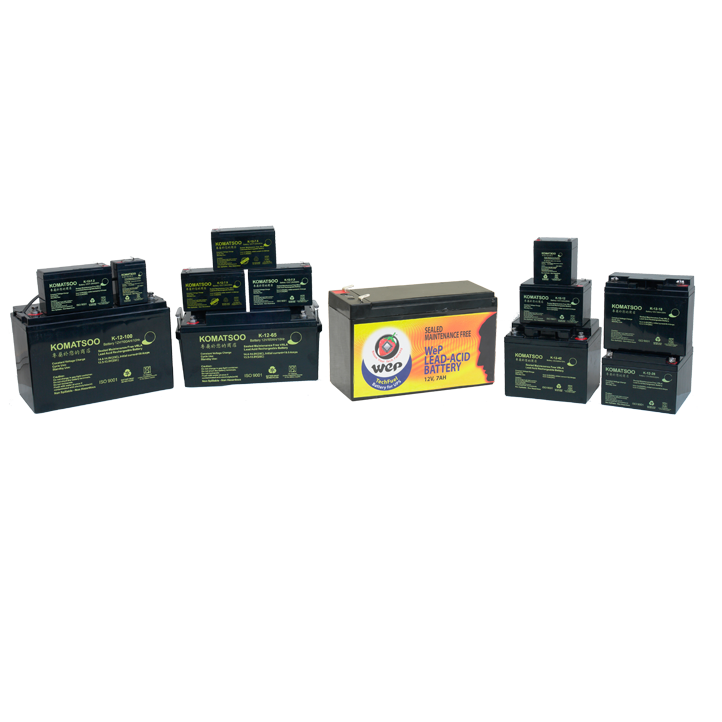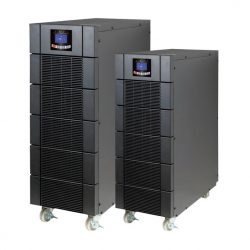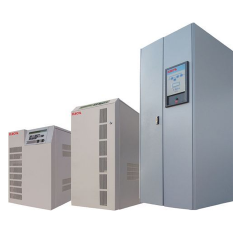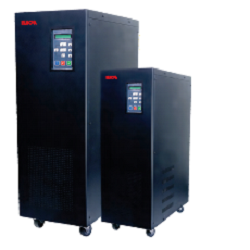| This document should be read before handling or using KOMATSOO sealed lead acid batteries. Improper usage can result in bodily injury caused by electrolyte leakage, heat generation or an explosion.
This gives various levels of care to be exercised during Storage, Installation, Usage, Handling and Operation, Maintenance, Disposal and Recycling of batteries.
1. DANGER: When the batteries are handled or used improperly, death or severe injury can occur due to excessive heat generation or a fire taking place or the batteries exploding.
- – Do not put batteries in airtight containers, as the batteries tend to generate inflammable gas upon excess charge and can explode.
- – Use only insulated tools, bare tools / metals could lead to short circuits between the battery +/- terminals.
- – Do not install batteries in a closed room without proper ventilation as batteries generate inflammable gases on over charging conditions.
- – Provide adequate insulation between the +/- wires and batteries to avoid occurrence of a short circuit condition.
- – Do not short the +/- battery terminals or the +/- wires connected to the battery terminals.
2. WARNING: When the batteries are handled or used improperly, serious bodily injury or damage to the product can occur.
- – Batteries must be charged as specified, otherwise they could leak, generate excessive heat or explode.
- – When using the battery in critical applications, such as medical equipment, incorporate a backup system other than the main battery to account for power failure.
- – Do not place batteries near a fire or heat source or devices which generate sparks, as the inflammable gasses generated by the battery could ignite and explode.
- – Do not use any resin containing a migrating plasticizer or organic solvents such as thinner, petrol, benzene, kerosene and liquid detergents to clean the battery, as these could cause the ABS Container to crack and leak.
- – Use rubber gloves when handling battery (banks) of greater than 45V.
- – Do not install batteries where they could come in contact with water or other liquids.
- – Never dispose batteries in a fire, they will explode.
- – Do not try to disassemble the battery as it could result in the leakage of sulfuric acid resulting in acid burns.
- – Use a damp cloth to clean the batteries instead of a dry cloth which could generate static electricity and sparking when the static charge is dissipated.
- – Replace batteries before their end of life, i.e. when the run time falls to less than 60% of their initial discharge duration, as the batteries will finally loose their capacity due to the drying up of the electrolyte (increased internal resistance) or occurrence of an internal short circuit KOMATSOO
3. CAUTION: When the batteries are handled or used improperly, minor injury or damage to the battery & product can occur.
-
- Batteries must be stored or used in the temperature range of:
Discharging: -15 to +50 DegC
Charging: 0 to +40 DegC
Storage: -15 to +40 DegC,
- – Temperatures above or below these ranges could result in damage or deformity of the battery.
- – Do not place batteries near a heat generating source like Heat Sinks or Transformers, or in the car exposed to direct sunlight and heat, as it may cause the battery to generate excessive heat, or leak or even explode, & could lead to reduction in the operating life of the battery.
- – Do not store batteries in dusty, humid or corrosive environments as this can lead to higher leakage currents between the +/- terminal, resulting in lower shelf – life, & corrosion of the terminals.
- – When two or more batteries are to be used to makeup a battery bank, first connect the batteries together and then connect to the UPS, Charger or Load. Ensure proper connections and maintain the +/- polarities, as reversal of polarity can result in excessive heat generation, a fire or explosion which could result in bodily injury and damage to the battery & the connected equipment.
- – When handling batteries, wear steel tipped shoes to prevent possible injury to the feet from a dropped battery.
- – When unpacking batteries handle the batteries carefully as any physical shock could result in cracking of the battery container, breakage or leakage of electrolyte.
- – When mounting the batteries in any equipment, ensure that the checking, connecting and replacing is easily possible. Batteries must be located in the lowest part of the equipment. Do not charge batteries in the upside down position as it can result in electrolyte leakage from the vents. Batteries can be used in the upright, vertical & side positions.
- – Do not lift / carry the batteries by their terminals or wires.
- – Do not try to charge the batteries directly from the car cigarette lighter, use a specified charger between the battery and the outlet / receptacle.
- – Turn off the equipment / charger On-switch when connecting the battery (bank) to the equipment.
- – When using the batteries for the first time, check for terminal rusting, case deformities or leakage, and such batteries should not be used.
- – To prevent accidents, change any battery found having a crack, deformity or leakage.
- – If the charger is found to be defective generating higher voltages, then replace all the batteries with new ones.
- – If the batteries are charged with inverted (+-) polarities, it could cause leakage, heat generation or a fire and will damage the battery.
- – Do not solder directly on the battery terminals as this could result in leak of electrolyte through a crack / break in the seal(s) at the terminal base.
- – Batteries in a battery bank: use batteries only of the same V & AH ratings, from the same lot and manufacturer and with the same charge / discharge history.
- – Do not over charge the batteries as it could result in the deformity of the battery container, leakage, heat generation and explosion,
- – Do not allow children to handle the batteries.
4. CAREFUL: When the batteries are handled or used improperly, deterioration of the battery quality and performance may occur.
- – Dropping a battery could result in internal damage also, thereby deteriorating the battery performance and could result in premature failure and reduced operating life.
- – Differences in the charge and discharge methods can lead to a large difference in operating times and life of the battery.
- – As batteries tend to loose their charge during shipping and storage, they must be recharged to restore their full capacity Constant Voltage charging(CV) : Charger voltage is kept at 2.4 to 2.5V/Cell,
Initial charging current < 0.1C to 0.4C
(C = AH value of the battery)
Maximum charging time = 24 Hours.
Constant Current charging(CC) : Charging current < 0.1C
Charging time (in Hours) =
[Amount of self discharge in AH / 0.1C]*120%.
Charge Time in any case < 12 Hours, max.
– The self discharge, loss of AH capacity, is proportional to the storage temperature and conditions, and storage – time, and a rough calculation can be done to determine the capacity loss during storage.
- – The cut-off voltage during discharge will vary depending on discharge current, batteries should not be discharged below the specified cut off voltage value. Recharging an over discharged battery may generate heat resulting in deformation of the battery or / & condensation around the battery vents as the moisture within the battery evaporates, and battery efficiency would eventually fall.
- – Batteries must be recharged immediately after discharge, even if not discharged up to the cutoff voltage, to prevent sulphation of the plates and hence loss of AH capacity.
- – When batteries are used in cyclic applications it is important to charge the battery properly and must not be removed from charge till it is fully charged.
- – Avoid Parallel Charging of batteries in cyclic use, as battery life may be reduced due to an imbalance in the charge / discharge characteristics of the batteries.
- – The Trickle / Float Charge voltage must be carefully controlled as lower voltages will lead to loss of capacity due to insufficient charging, and if the voltage is higher than specified then the batteries may again loose their capacity by damage due to overcharging and may suffer thermal runaway phenomenon.
- – Switch Off equipment if not in use to prevent discharging of the connected batteries.
- – When storing batteries, disconnect them from the charger, equipment or load to prevent over discharge and loss of capacity.
- – Keep the battery terminals clean in order to avoid disruption of the charging / discharging currents.
- Charge the batteries based on storage temperatures, as below:
£ 20 DegC Storage —— charge every 9 months
20 – 30 DegC Storage — charge every 6 months
20 – 40 DegC Storage — charge every 3 months
- – Fully charge the batteries before storing them, to prevent loss of capacity or shortening of battery life.
- – Use the batteries on a first – come basis, as batteries gradually deteriorate even under proper storage conditions.
|





